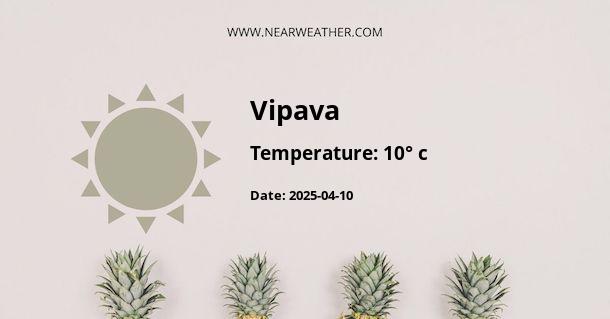Understanding the Climate and Weather Patterns of Vipava, Slovenia
Vipava, a picturesque valley situated in the western part of Slovenia, is renowned for its unique climate and weather patterns that contribute to its lush landscapes and thriving viticulture. This small but charming location boasts a climate influenced by a mix of Mediterranean, Alpine, and continental air masses, creating a microclimate that is both varied and complex.
Vipava's Geographical Influence on Climate
The Vipava Valley lies at the crossroads of various geographical features, which shape its climate significantly. To the north, the towering Julian Alps and to the east, the plateau of the Trnovo Forest create a barrier, while the valley opens towards the Adriatic Sea to the south-west. This topography allows for the mixing of different climatic influences, which gives Vipava its characteristically variable weather.
Temperature Patterns Throughout the Year
The temperature in Vipava exhibits contrasts throughout the year, with warm summers and cooler winters, though the proximity to the sea tends to moderate the extremes. Below is a summary table of average temperatures in Vipava:
| Season | Average Temperature Range (°C) |
|---|---|
| Winter (Dec-Feb) | 0 to 8 |
| Spring (Mar-May) | 8 to 20 |
| Summer (Jun-Aug) | 18 to 30 |
| Autumn (Sep-Nov) | 10 to 22 |
Note: These temperatures are indicative and subject to change yearly due to global climate patterns.
Precipitation and Humidity
Precipitation in Vipava is another notable aspect that contributes to its lush vegetation and successful wine production. The region experiences moderate to high rainfall, with autumn being particularly wet, contributing to harvests and the replenishing of local aquifers.
- Spring: This season brings moderate rainfall, helping to encourage plant growth after the winter.
- Summer: Precipitation is lower, though occasional thunderstorms can occur, often providing a reprieve from the heat
- Autumn: Known for being the wettest season, autumn prepares the ground for the cooler temperatures of winter.
- Winter: Snowfall is infrequent in the valley itself, occurring more often on the surrounding highlands.
The Famous Vipava Winds
The local climate is heavily influenced by the Vipava winds, particularly the "Bora" and the less intense "Jugo". The Bora is a cold, dry wind that descends from the northeast, funneling through the valley at high speeds and significantly impacting the daily weather. In contrast, the Jugo is a southeastern wind bringing moisture and often precedes rainfall. These winds contribute to the air circulation in the valley and are integral to maintaining the health of Vipava's vineyards.
Viticulture and the Importance of Climate
The unique microclimate of Vipava has nurtured a long-standing tradition of viticulture, which is the cornerstone of the region's economy and cultural heritage.
"The mosaic of the Vipava Valley's micro locations, with their own microclimates, is captured in the wines. The wind, the sun, and the soil breathe through them." - Local VintnerThe temperature variations, soil types, and the influence of the winds result in a terroir that is conducive to producing a variety of grapes with distinct characteristics. Vintners in Vipava can grow both international grape varieties as well as indigenous Slovenian grapes like Zelen and Pinela, which are well-adapted to the microclimate of the area.
Climate Change and Its Impact on Vipava
As with many regions across the globe, climate change poses a real and significant threat to the Vipava Valley. Recorded changes in temperature and precipitation patterns have prompted viticulturists and farmers to adapt their practices. Increasingly unpredictable weather, such as unseasonal frosts or heatwaves, can harm crops and jeopardize the delicate balance of this agrarian economy.
- Vintners are considering grape varieties that can better withstand temperature extremes.
- Water management strategies are being adjusted to cope with variable rainfall.
- Wind patterns, which can be both beneficial and destructive, are closely monitored for better planning and preparation.
Visitor Considerations for Vipava's Weather
For visitors planning to experience the beauty and offerings of the Vipava Valley, understanding and preparing for the local weather conditions is vital. Here are some tips based on Vipava's climate:
- Best Time to Visit: Late spring to early fall provides the most pleasant weather for exploring the outdoors and wine tasting.
- Wine Harvest Season: Autumn is harvest time and many wineries offer tastings and tours, though be prepared for wetter weather.
- Outdoor Activities: If you're into hiking or cycling, aim for late spring or early summer when temperatures are moderate and the scenery is vibrant.
- Winter Visits: While quieter and cooler, winter in Vipava can offer its own charm. Just pack warmer clothes and watch out for the Bora wind!
Vipava's climate and weather patterns carve out a spectrum of conditions that directly influence the landscape, lifestyle, and the wine that originates from this lush Slovenian valley. Whether you're a visitor seeking the aromatic wines of the region or a researcher delving into climate patterns, Vipava stands as a fascinating case study on the profound impact of weather on local culture and economy.
A - Vipava's Latitude is 45.846668 & Longitude is 13.963060.
A - Weather in Vipava is 19° today.
A - Climate Conditions in Vipava shows clear sky today.
A - Humidity in Vipava is 67% today.
A - Wind speed in Vipava is 10.73 km/h, flowing at 55° wind direction. today.
